Donkey Kong Jr. (Arcade)
| Donkey Kong Jr. |
|---|
|
Also known as: Donkey Kong Junior
|
Donkey Kong Jr. is the next exciting chapter in the Donkey Kong saga. Mario has captured Donkey Kong. Free Donkey Kong! Beat Mario!
Contents
Anti-Piracy Check
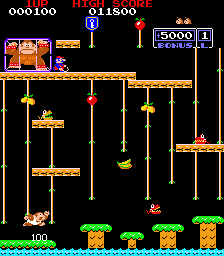
Before any stage is loaded, the game runs a checksum routine on RAM 37FB to 3801, which normally stores the "NINTENDO" part of the title screen's copyright graphic. If the checksum doesn't match, the game will be altered in the following ways:
- The first Snapjaw will turn orange.
- The topmost Snapjaw's Y position will go crazy until he eventually lands on the third platform in the water.
- Blue Snapjaws will start falling through floors.
- Any time Donkey Kong Jr. jumps, the game acts as if he jumped over an enemy.
- Most importantly, Jr. won't be able to climb vines, making the game impossible to play.
To see it for yourself, add the following code to dkongjr.xml:
<cheat desc="Anti Piracy">
<script state="run">
<action>maincpu.mb@37FB=1F</action>
</script>
</cheat>
This alters the first byte of the Nintendo copyright text which triggers the anti-piracy.
Unused Graphics
![]()
This lightbulb is located with the fruit graphics. It was probably intended to be used in Mario's Hideout, but the standard fruits are used instead.

These graphics are leftovers from Donkey Kong, and have no use in this game. Interestingly, the leftovers include the hidden Ikegami Tsushinki logo despite them having had no involvement with Jr. (Nintendo instead hired Iwasaki Engineering to reverse-engineer Ikegami's code, which resulted in Ikegami suing Nintendo).
![]()
The last part of Nintendo's full name, which they did opt to be credited by in the NES port.
Version Differences
Title Screen
| Donkey Kong Junior | Donkey Kong Jr. |
|---|---|
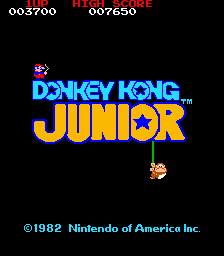 |
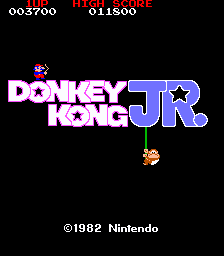 |
The two "main" versions of the game have different title screens. The earlier version (also the only one released in America) does not abbreviate the title, has a trademark symbol and uses a different title screen palette. Jr. had to be moved a bit as a result of all this.
Scores
| Donkey Kong Junior | Donkey Kong Jr. |
|---|---|
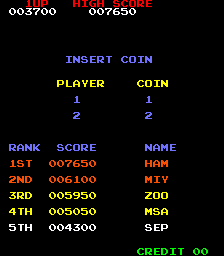 |
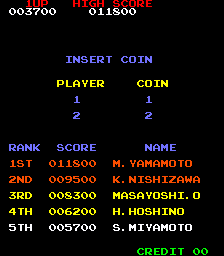 |
Donkey Kong Jr. expands the number of characters in the high score screen from 3 to 12. The default high scores were increased, as well.
Level Order
All versions of the game besides the US F-2 set have a consistent stage order: 1-2-3-4, repeating infinitely. The US F-2 set uses an order similar to (but different from) the US version of Donkey Kong: 1-4, then 1-2-4, then 1-3-4, then finally 1-2-3-4, matching the Japanese version. This last order repeats until the end of the game.
The new level order has the consequence of making the "KEEP GOING TO MARIO'S HIDEOUT" intermission cutscene take 2 loops to appear, since it only appears before stage 3, even though stage 4 takes place in Mario's Hideout as well.
References
- ↑ 【ドンキーコングJrの著作権の帰属(ドンキーコングJr事件)】 - mc-law.jp, January 4th, 2017
- ↑ 元任天堂・岡田 智氏の独立独歩 前編 “技術的に不可能”を覆したゲーム&ウオッチ 「ビデオゲームの語り部たち」:第27部 - 4gamer.net, March 28th, 2022
- ↑ コーチ紹介 - ogatacoach.com
- Pages missing developer references
- Games developed by Nintendo R&D1
- Games developed by Iwasaki
- Pages missing publisher references
- Games published by Nintendo
- Arcade games
- Pages missing date references
- Games released in 1982
- Games released in August
- Games released on August 13
- Games released in September
- Games released on September 19
- Games released in October
- Games released on October 4
- Games released in November
- Games released on November 23
- Games with unused graphics
- Games with regional differences
- Games with anti-piracy methods
- Donkey Kong series
- Mario series
Cleanup > Pages missing date references
Cleanup > Pages missing developer references
Cleanup > Pages missing publisher references
Games > Games by content > Games with anti-piracy methods
Games > Games by content > Games with regional differences
Games > Games by content > Games with unused graphics
Games > Games by developer > Games developed by Iwasaki
Games > Games by developer > Games developed by Nintendo > Games developed by Nintendo EPD > Games developed by Nintendo SPD > Games developed by Nintendo R&D1
Games > Games by platform > Arcade games
Games > Games by publisher > Games published by Nintendo
Games > Games by release date > Games released in 1982
Games > Games by release date > Games released in August
Games > Games by release date > Games released in August > Games released on August 13
Games > Games by release date > Games released in November
Games > Games by release date > Games released in November > Games released on November 23
Games > Games by release date > Games released in October
Games > Games by release date > Games released in October > Games released on October 4
Games > Games by release date > Games released in September
Games > Games by release date > Games released in September > Games released on September 19
Games > Games by series > Donkey Kong series
Games > Games by series > Mario series